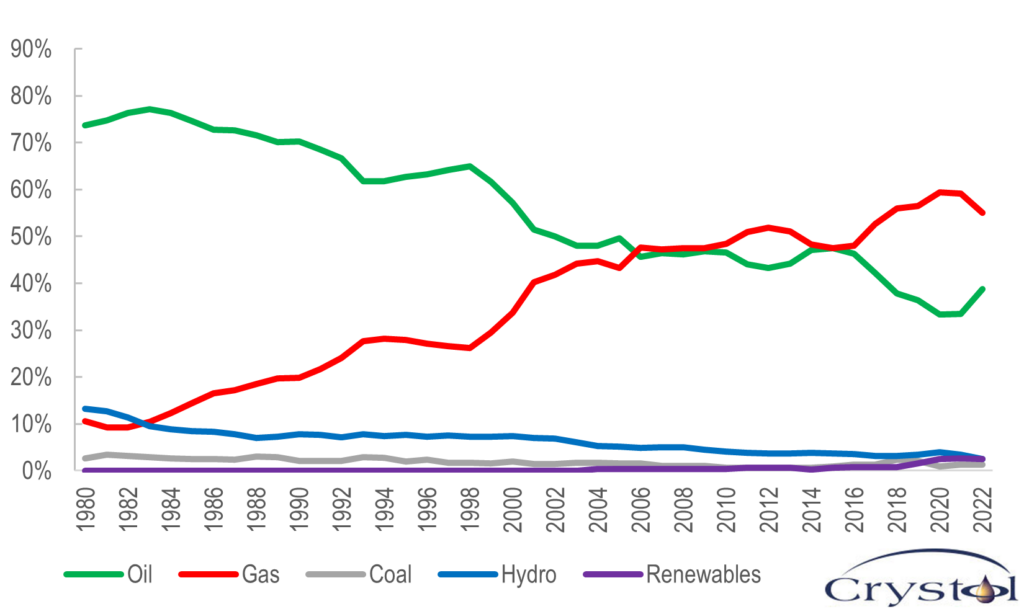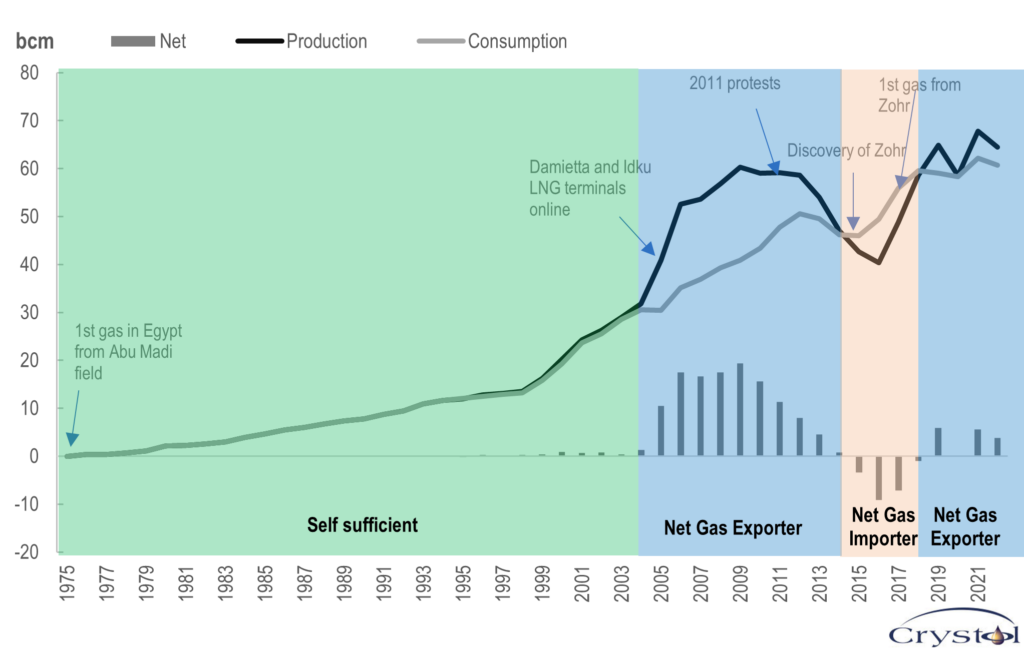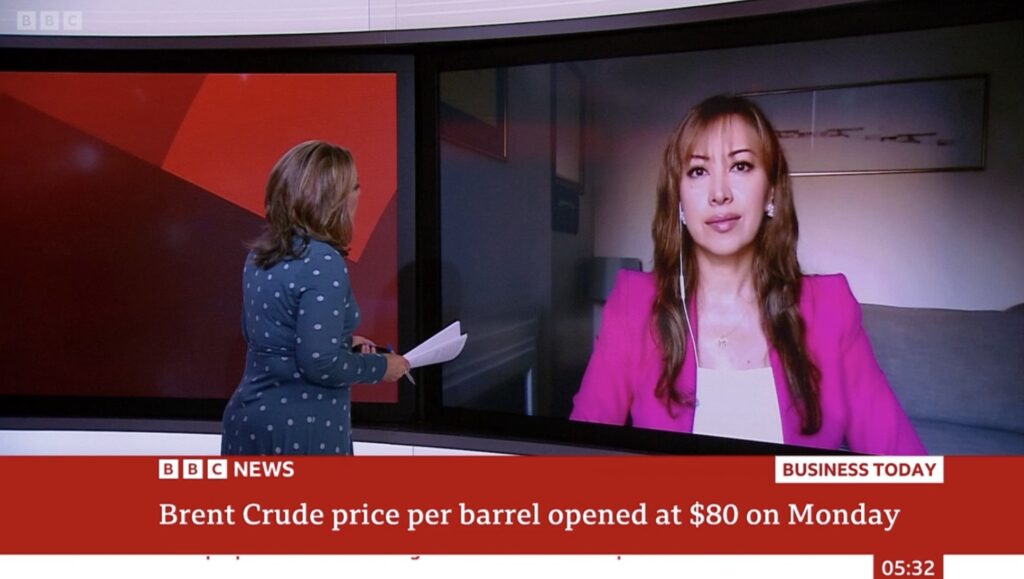Dr Carole Nakhle
It is hard to imagine that Egypt, currently the world’s 12th largest exporter of liquefied natural gas (LNG), is suffering an acute domestic fuel shortage. But power blackouts have been the norm this summer. The government announced several measures to ease the crisis, including outages and mandatory work-from-home days for civil servants.
While recurring summer heat waves and a higher demand for cooling are to blame for the crunch, the crisis reflects a deeper problem – a limitation in Egypt’s gas production capacity. It raises questions about the country’s export potential and has implications for buyers in Europe and elsewhere.
Unless new significant discoveries are made in Egypt, its domestic gas consumption is reduced and local prices align with those in the international market, the country’s standing as a major gas exporter will be compromised, along with its ambition to become a regional gas hub.
When domestic gas demand outruns production
Natural gas dominates Egypt’s primary energy and electricity-generation mixes, accounting for 55 percent and 84 percent, respectively. The power sector is the biggest fuel user, accounting for more than 62 percent of the domestic consumption.
Between 2002 and 2012, local demand grew in Egypt by an annual average of 7.1 percent (compared to a global average of 2.9 percent and an African average of 5.5 percent). That demand was primarily driven by subsidized gas prices and a government policy that encouraged the use of gas in industrial applications and power generation.
Over time, subsidized energy has become essential to the country’s social contract. In 2022, Egypt consumed 60.7 billion cubic meters (bcm) of gas, equivalent to 37.3 percent of Africa’s total gas consumption, making it the continent’s largest gas market.
When domestic production growth could not meet local demand, the Egyptian government introduced reforms in 2014 to phase out gas subsidies. In 2016, the International Monetary Fund (IMF) agreed to help finance the reform with an Extended Fund Facility (EFF), and Egypt pledged to end energy subsidies. However, to date, fully market-based prices have not materialized.
To an extent, the reforms succeeded in reducing domestic demand growth. Between 2014 and 2018, Egyptian gas consumption grew by 13.4 bcm (6.6 percent) annually and only by 1.1 bcm (0.5 percent) between 2018 and 2022. However, absent further reforms and due to Egypt’s failure to come close to its ambitious green energy target (of 42 percent of renewables in the power sector by 2030, up from around 5 percent today), and in the light of its continuing demographic and economic expansion, the domestic demand for gas is bound to accelerate again.
Egypt’s energy mix evolution

Data source: Energy Institute
Production: Unrealized potential
On the supply side, Egypt is a player in gas markets. It holds 2.1 trillion cubic meters (tcm) of proven gas reserves, equivalent to 16.3 percent of proven reserves in the African continent, which ranks it only after Nigeria (5.5 tcm) and Algeria (2.3 tcm).
Egypt has produced natural gas for domestic use since the mid-1970s, fully meeting its needs. In 2004, its gas output exceeded consumption, and the surplus was exported. The surplus lasted for a decade. By 2014, Egypt struggled to sustain production growth and became a net gas importer. Limited investment was the leading cause, partly because the Egyptian government was in arrears to oil and gas companies and partly due to the political instability that followed the 2011 Egyptian revolution and the ousting of longtime President Hosni Mubarak (1981-2011). The country’s gas production was shrinking at an average annual rate of 14.5 percent until 2016, when output reached around 40 bcm, or 33.7 percent below its 2009 peak.
Steps in the right direction
To reverse the trend, the Egyptian government awarded new exploration licenses with more attractive terms to investors. That effort paid off. In 2015, Italian Eni announced the discovery of the Zohr field, which rewrote Egypt’s gas fortunes. Not only is Zohr the biggest gas field discovered in the Eastern Mediterranean region, but Eni, its operator, succeeded in bringing it onstream in less than two and a half years from discovery – a record time for a deepwater field of this size. The existing infrastructure in Egypt facilitated its rapid development. Production from Zohr started in 2017 and reversed the decline in Egypt’s production. In 2022, Egypt produced 64.5 bcm, 7 percent higher than its previous peak and more than a quarter of Africa’s gas production.
Further discoveries have followed, though none with the same weight as Zohr. In December 2022, Tarek El Molla, Egypt’s petroleum minister, stated that the country intended to invest $2.1 billion in oil and natural gas exploration by 2025.
The scale of potential discoveries will dictate the outlook for Egypt’s production and exports. Absent more Zohr-like finds, Egypt’s gas production is expected to peak by 2028 (at below 80 bcm). In contrast, there is no sign of a peak in gas demand anytime soon.
Egypt’s gas production-consumption trends

Data source: Energy Institute
Egypt’s asset: gas exports infrastructure
Egypt’s gas export infrastructure was primarily developed in the early 2000s when gas production exceeded domestic consumption. The country has one operational gas export pipeline called the Arab Gas Pipeline that links it to Jordan, Syria and Lebanon. The pipeline is nearly two decades old and has a yearly capacity of 10 bcm. However, Syrian parts of the facility have been damaged during the civil war and flows to Syria and Lebanon remain disrupted.
Egypt has two onshore LNG liquefaction plants and terminals (at Idku and Damietta) that have enabled the country to export LNG to global markets since 2005. These plants are presently Egypt’s only operating export routes. At full capacity, they produce nearly 5 percent of the European Union’s gas consumption in 2022.
However, the plants were under-utilized for much of the past decade. After Egypt became a net gas importer in the early 2010s, Damietta closed in 2013 and Idku in 2015 (liquefying minimal volumes continued to keep the equipment running). However, the production of gas at Zohr and the export of gas from Israel into Egypt enabled the reopening of Idku in 2020 and Damietta in 2021.
In 2022, Egypt exported 8.9 bcm of its LNG to world markets, accounting for 1.6 percent of the global LNG trade. However, unlike in 2021, when Asia absorbed 71 percent of its exports, 73 percent of Egyptian LNG went to Europe in 2022, as Egypt took advantage of higher gas prices caused by the war in Ukraine.
Such flexibility in redirecting LNG flows is undoubtedly an advantage. However, Egypt’s longer-term export outlook depends on its production and consumption growth. Some analysts see Egyptian LNG exports peaking already in 2023 and declining after that, as domestic demand growth weighs down on exports. That is not an implausible scenario under existing circumstances.
EU-supported energy hub ambition
Egypt hopes to become a focal point for regional gas trade, facilitating exports of the essentially stranded gas in the Eastern Mediterranean. Compared to its neighbors, Egypt has an established gas transport infrastructure. Israel already sends its gas to Egypt through the Eastern Mediterranean Gas pipeline (also known as Arish-Ashkelon pipeline). From there, the commodity can be transported for liquefaction in Egyptian terminals for export.
The partners in Cyprus’s largest gas field, Aphrodite, discovered in 2011, also hope to capitalize on Egypt’s infrastructure to initiate gas exports from the island. Despite making its first discovery over 12 years ago, Cyprus has yet to begin extracting and exporting its gas. And Lebanon, if it ever starts producing gas, could be sending it through the Arab Gas Pipeline to Egypt and from there to global markets.
As part of the EU’s drive to secure non-Russian gas supplies, Brussels signed a memorandum of understanding (MoU) with Egypt and Israel. The idea is to enable a stable delivery of natural gas to Europe based on the principles of market-driven pricing and make shipments of Israeli gas go to Europe via Egyptian export terminals. Earlier, in 2018, Brussels signed a MoU with Egypt on the EU’s support for Egypt’s energy sector and the country’s energy hub ambition.
Scenarios
Given the technical, commercial and political challenges that its neighbors in the Eastern Mediterranean face when planning their gas exports, Egypt may have a good chance of achieving its regional hub ambition. To succeed, however, the project requires diverse gas suppliers and customers, steady political will and a liberalized gas market. Not all of these conditions have been met.
Although price reforms have been introduced over the last few years, market liberalization is yet to occur in Egypt. In January 2023, the Egyptian government announced that it was considering “introducing an indexation mechanism for the domestic price of natural gas so that it reflects international prices” – a promise yet to be fulfilled.
Also, several risks are associated with relying on Egypt as a focal and, in some cases, the only reexport point for its neighbors.
The Fund for Peace has assigned a “warning” to Egypt in its Fragile States Index. Despite the country’s relative stability since the army took control during the Arab Spring protests, an underlying risk of social and political unrest remains. In particular, the share of Egypt’s youth not in education, employment or training remains high at nearly 30 percent, and stubbornly high headline inflation has hovered around 30 percent in 2022-2023, with food inflation at some 60 percent, causing an alarming erosion in most Egyptians’ living standards. The suppliers who rely on Egyptian infrastructure and customers placing their bets on Egyptian gas can, therefore, become too exposed to that country’s political and economic fragility and the vagaries of its domestic market that still features regulated prices and may crowd out exports again.
Facts & Figures
The Arab Republic of Egypt is:
- the most populous country in the Arab world with a population nearing 113 million (Wordometer), and the third-largest in Africa after Nigeria and Ethiopia
- the third-biggest economy on the African continent (after Nigeria and South Africa) and in the Middle East-North Africa region, after Saudi Arabia and the United Arab Emirates (IMF)
- an emerging market and developing economy classified as lower middle-income with a gross domestic product per capita of $4088 in 2022 (TradingEconomics)
- the world’s 17th-largest gas producer
- relying heavily on Zohr gas field, which accounts for nearly 38% of its gas output
- making new discoveries of oil and gas; recorded 53 of them in 2022
- exporting gas to many corners of the world; last year, Turkey, Spain and France were the largest buyers of Egypt-produced LNG in Europe; South Korea, China and India were the top buyers in Asia
Related Analysis
“Australia’s LNG success may be at risk” Dr Carole Nakhle, Aug 2023
“A new era for natural gas markets” Dr Carole Nakhle, Jul 2023
Related Comments
“European gas crisis persists“, Dr Carole Nakhle, Aug 2023
“Egypt’s LNG exports to Europe receive boost amid gas crisis” Dr Carole Nakhle, Jul 2022








